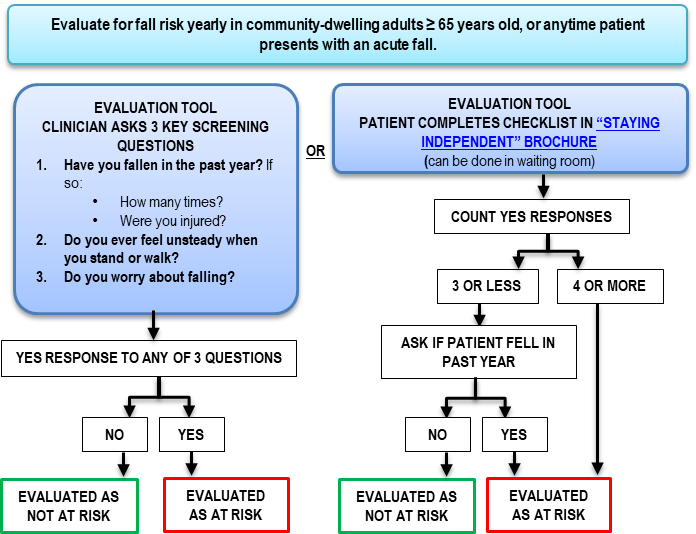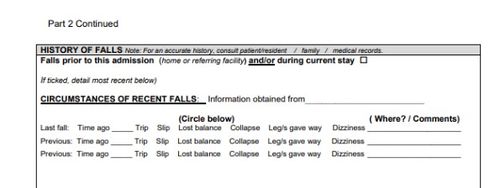All About Dementia Fall Risk
All About Dementia Fall Risk
Blog Article
Getting My Dementia Fall Risk To Work
Table of ContentsWhat Does Dementia Fall Risk Do?4 Simple Techniques For Dementia Fall RiskExcitement About Dementia Fall RiskThe Definitive Guide for Dementia Fall Risk
A loss risk analysis checks to see just how most likely it is that you will certainly fall. It is mainly provided for older grownups. The assessment normally consists of: This includes a series of concerns about your overall health and wellness and if you've had previous falls or problems with balance, standing, and/or strolling. These tools check your strength, balance, and gait (the means you walk).Treatments are recommendations that may reduce your threat of falling. STEADI consists of 3 steps: you for your danger of falling for your risk aspects that can be enhanced to try to stop falls (for instance, equilibrium problems, impaired vision) to minimize your risk of dropping by making use of effective methods (for example, supplying education and learning and sources), you may be asked numerous concerns consisting of: Have you dropped in the past year? Are you stressed about falling?
Then you'll rest down once again. Your supplier will examine how much time it takes you to do this. If it takes you 12 seconds or more, it may indicate you are at greater danger for a loss. This examination checks stamina and equilibrium. You'll sit in a chair with your arms crossed over your upper body.
Move one foot midway ahead, so the instep is touching the large toe of your various other foot. Move one foot completely in front of the other, so the toes are touching the heel of your various other foot.
Fascination About Dementia Fall Risk
Most drops take place as a result of multiple contributing factors; for that reason, handling the risk of dropping begins with determining the elements that add to fall danger - Dementia Fall Risk. Some of the most pertinent risk elements include: History of prior fallsChronic medical conditionsAcute illnessImpaired stride and balance, reduced extremity weaknessCognitive impairmentChanges in visionCertain risky medications and polypharmacyEnvironmental factors can also increase the danger for falls, including: Poor lightingUneven or harmed flooringWet or unsafe floorsMissing or harmed handrails and get hold of barsDamaged or poorly equipped equipment, such as beds, mobility devices, or walkersImproper usage of assistive devicesInadequate guidance of individuals residing in the NF, including those that display aggressive behaviorsA effective loss danger monitoring program requires a thorough scientific analysis, with input from all members of the interdisciplinary team

The care strategy ought to likewise include interventions that are system-based, such as those that advertise a safe atmosphere (proper illumination, hand rails, get hold of bars, and so on). The efficiency of the interventions should be reviewed occasionally, and the treatment strategy modified as required to reflect adjustments in the loss threat analysis. Carrying out a fall danger administration system utilizing evidence-based ideal practice can decrease the prevalence of drops in the NF, while restricting the capacity for fall-related injuries.
Rumored Buzz on Dementia Fall Risk
The AGS/BGS standard suggests evaluating all grownups matured 65 years and older for autumn danger each year. This screening contains asking individuals whether they have actually fallen 2 or even more times in the past year or looked for clinical interest like it for a fall, or, if they have actually not fallen, whether they feel unsteady when walking.
People that have fallen as soon as without injury should have their balance and stride assessed; those with stride or equilibrium problems ought to obtain extra assessment. A background of 1 autumn without injury and without stride or balance issues does not necessitate further evaluation past ongoing yearly fall danger testing. Dementia Fall Risk. A loss threat evaluation is called for as part of the Welcome to Medicare assessment

See This Report on Dementia Fall Risk
Documenting a drops background is one of the quality indications for fall prevention and administration. copyright drugs in certain are independent forecasters of falls.
Postural hypotension can commonly be eased by decreasing the dose of blood pressurelowering medications and/or stopping medications that have orthostatic hypotension as a negative effects. Use above-the-knee support hose and sleeping with the head of the bed boosted might likewise reduce postural decreases in blood stress. The preferred elements of a fall-focused checkup are displayed in Box 1.

A yank time higher than or equal to 12 seconds recommends high autumn danger. The 30-Second Chair Stand examination analyzes lower extremity strength and balance. Being unable to stand up from a chair of knee elevation without making use of one's arms indicates increased loss risk. The 4-Stage Equilibrium test examines fixed balance by having the person stand in 4 placements, each progressively a lot more tough.
Report this page